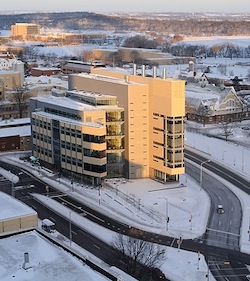Energy institute fueling innovation in new facility
A group of UW alumni from the College of Engineering take a tour of the Wisconsin Energy Institute building, which is designed to use natural light to reduce its energy consumption. The building will serve as a center for clean energy research and education.
Photo: Bryce Richter
Gazing out at the roughly 60,000 cars that cross the intersection at the Wisconsin Energy Institute’s (WEI’s) doorstep, the reason the building exists is clear — energy consumption and dependence on fossil fuels — and WEI’s research is poised to address the problem.
The WEI building at 1552 University Ave. will be dedicated Friday, April 5 with the public invited to two days of opening events, including an energy career fair, a symposium celebrating energy research, and family-friendly, hands-on activities on Saturday, April 6.

The new Wisconsin Energy Institute building is located at the intersection of Old University Avenue (left) and Campus Drive.
Photo: Jeff Miller
In design, execution and location, WEI officials say, the facility represents the research it houses: sustainable and collaborative. From schematics to construction, the design team incorporated features to aid in reducing energy consumption from a typical lab building by more than 30 percent.
The building’s architecture guides natural light into and throughout its five floors. Sunlight penetrates the labs of bioenergy researchers finding innovative ways to turn inedible organic materials into fuels and chemicals, and passes through office windows of sustainability scientists monitoring and modeling how energy decisions we make today affect the world around us.
Located on the former site of University Health Services, the institute was designed and oriented specifically to utilize the daylight available there. Harvesting daylight to reduce energy use is one of many features that keep the 100,000 square foot space on track to receive LEED® Gold certification.
Where a parking lot once was, bioenergy gardens showcase energy crop contenders that could fuel your car, and situated nearby are drainage basins that slow runoff and contribute to improved water quality.
Just as light flows freely between floors, open sightlines, “highways,” and weekly “tea times” encourage researchers and staff to exchange ideas with colleagues who may work in different departments or colleges.
“This new building will help us pull together efforts from across the University of Wisconsin–Madison campus to find new and innovative energy solutions,” says WEI Director Mike Corradini. “It signals to the world that we’re moving forward in energy.”
More information about the WEI opening events can be found here.
—Eric Anderson
Tags: biosciences, energy, research




